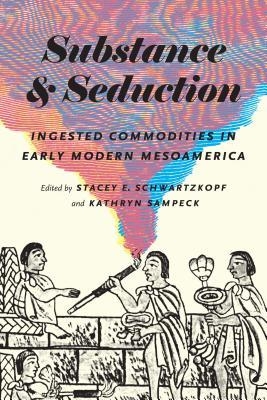Substance and Seduction: Ingested Commodities in Early Modern Mesoamerica by Stacey Schwartzkopf

CHAPTER ONE
Sandcastles of the Mind:
Hallucinogens and Cultural Memory
MARTIN NESVIG
PEOPLE IN MEXICO HAVE BEEN EATING HALLUCI nogens—including Psylocibe
mushrooms and peyote cactus—for a long time, maybe as long as millennia,
the archaeological evidence suggests. The principal hallucinogens, or “psychodysleptics,”
of Mexico, understood as powerful, magical, and associated with ritual
practice, were peyote, teonanacatl (the hallucinogenic Psilocybe mushrooms),
and ololiuqui (morning glory seeds). Peyote (from the Nahuatl
peyotl) use was primarily located in north-central Mexico since the
plant, the semi-cactus Lophophora williamsii, is autochthonous to the arid
mountains of Zacatecas, San Luis Potosí, Coahuila, and the lower Rio
Grande valley. Given the paucity of written sources prior to contact
between Spaniards and Mesoamericans, it is diffi cult to gauge precisely
the range of peyote use; its use aft er contact continued to be mostly
limited to the regions where it grows and other regions close by. Archaeological
fi nds have located peyote use possibly as early as 5000 BCE
in rock shelters in the Trans-Pecos area. In addition to peyote, various other
plants were employed for ritual intoxication. Morning glory
seeds, ololiuqui, were ground and consumed as a method of sedation and
divination. The hallucinogenic mushrooms (genus Psylocibe)
known as teonanacatl in Nahuatl, meaning food or fl esh of the gods,
were consumed for purposes of divination and shamanism, primarily
in central Mexico.
We know very little about pre-Hispanic hallucinogen use except
from postcontact sources, archaeological materials depicting hallucinogens,
and a kind of reverse historicism based on presumed cultural substrata of ritual
peyote and mushroom ingestion. In this chapter I push
the boundaries of the possible a little by considering two issues con
cerning hallucinogen use. The fi rst is a kind of archaeology of memory, in this
case of things that do not get written down—namely, hallucinogenic trips—
and the cultural apparatus surrounding hallucinogen
consumption.
I take epistemological cues from historical anthropology, especially
from Greg Dening’s conceptualization of “deep memory” in his analysis of the
shared cosmologies of Polynesian societies.6 In the second
point of departure I examine how the Mesoamerican custom of consuming
hallucinogens began a process of creolization. Neither specifically indigenous
nor Catholic or Spanish, by the seventeenth century
hallucinogen use by Spaniards and people of mixed ethnicities demonstrated
the profound eff ect Mesoamerican customs would have on
Spanish colonials—inverting the dynamic of the colonial equation and
reversing the traditional focus on the impact of Spanish rule on indigenous
communities, instead assessing the “Indianization” of Spaniards
in Mexico.
I off er fi rst some tentative arguments about pre-Hispanic hallucinogen use in
Mexico and then trace the early adaptation of hallucinogen use by nonindigenous
people. This is part of a broader study of
the ways Spaniards in Mexico adopted Mesoamerican cultural behaviors. I identify
three phases of hallucinogen practice in Mexico.8 Phase
one is the prehistory of hallucinogen use, or of purely indigenous hallucinogen
use prior to 1519, about which we can speculate but for which
we have little concrete, explicit evidence. There is suggestive discussion of
the precontact ritual quality of hallucinogen use among Spanish
chroniclers and in early Inquisition cases against indigenous caciques.
The second phase spans roughly 1569 (when the fi rst recorded cases of
nonindigenous people consuming hallucinogens appear) to the 1630s
and encompasses the early processes of cultural adaptation. Hallucinogen
use was adopted by Spaniards and mixed-ethnic people; the resulting cultural
practice suggests the adoption of practical uses of hallucinogens with a patina
of ritual values. Phase three, in the second half of
the seventeenth century, was that of a mature creolized ritual-cultural
complex in which peyote in particular was clearly and demonstrably associated
with the Virgin of Guadalupe and ritual sacredness of both indigenous pagan
and Spanish Catholic values. I focus largely on some of
the bedrock cultural rituals associated with phase one and processes of
partial acculturation of phase two.
In between this century of chronological time and geographical
space (ca. 1500–1630), peyote and teonanacatl collapse the degree of
separation, closing the gap, leaving us to wonder when exactly the shift to
Substance and Seduction: Ingested Commodities in Early Modern Mesoamerica by Stacey Schwartzkopf




